Unique aspects of Climbing Kilimanjaro during Full Moon
1. Magical Moonlit Trail
One of the most obvious aspects of Climbing Kilimanjaro During a Full Moon is its natural illumination of the trails. The summit day, typically a challenging and dark climb, becomes a mesmerizing journey under the silver glow of the full moon. The moonlight casts a soft, magical glow on the landscape, revealing the intricate details of the rugged terrain and the surrounding peaks. Climbers often find that they don't need their headlamps as the moonlight gives sufficient visibility adding a breathtaking quality to the trek. This not only enhances the visual experience but also makes navigation easier, reducing stress and improving morale.
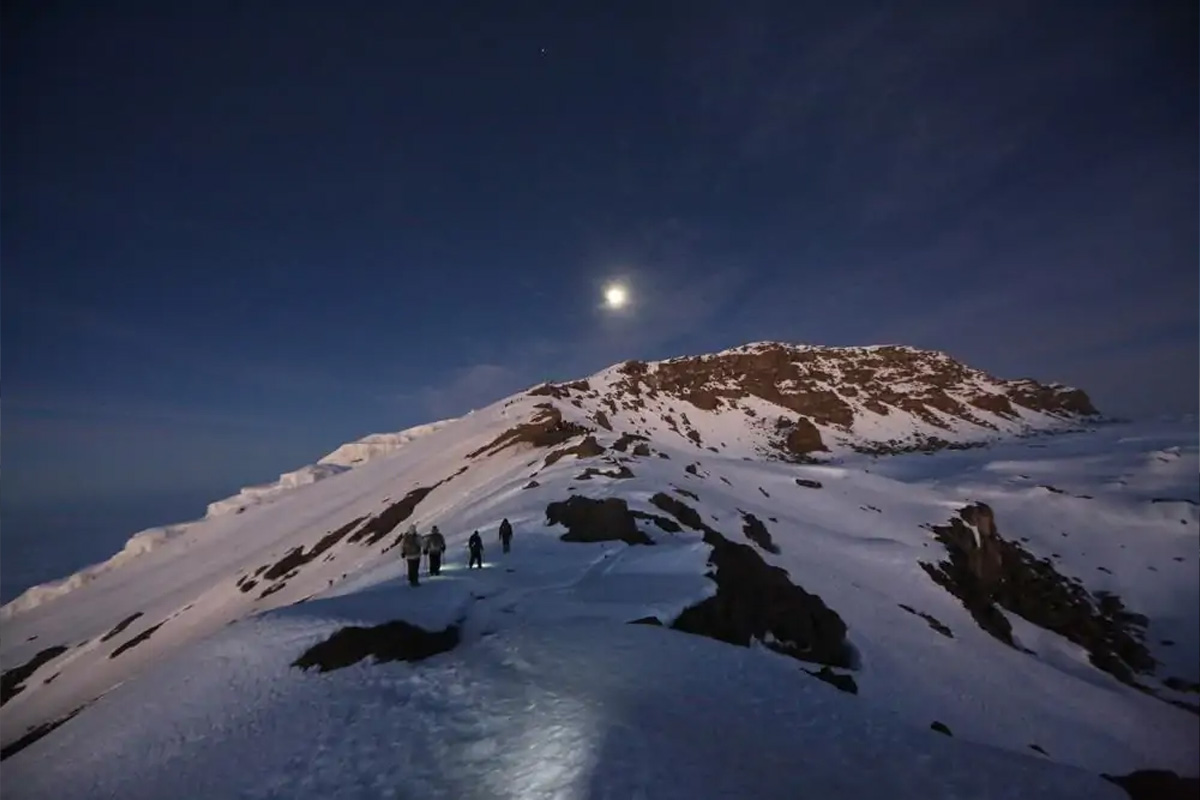
2. Stunning Night Views
One of the first-hand rewards of Climbing Kilimanjaro on Full Moon is the unparalleled views at night. As you climb higher, the vast African plains below appear bathed in a silverlight, creating a serene and almost dreamlike panorama. From the higher altitudes, you can clearly witness distant mountain ranges and rolling landscapes glowing softly under the moonlight.
This visual treat adds an extra layer of beauty to the climb, as the mountain takes an entirely new character during full-moon night. The moonlit scenery creates a sense of vastness and connection with nature offering the climbers the moment of peace and awe as they witness the magical beauty of Africa under the Full-Moon.
Mount Kilimanjaro Climate Zones: A Journey Through Earth's Climate in One Mountain
3. Enhanced Safety
Climbing at night can be intimidating, especially on the steep and rocky trails of Kilimanjaro. However, the full moon offers natural illumination enhancing the safety of the climbers. The bright moonlight improves visibility, making it easier to identify and navigate around the obstacles on the trail. Full Moon adds benefit during the summit push, where uneven terrain and loose scree can pose challenges. Guides can also monitor climbers more effectively, ensuring that everyone stays on course and potential hazards. The additional moonlight not only boosts confidence but also allows climbers to focus more on the experience and less worrying about the terrain. This practical advantage makes the Kilimanjaro Full Moon Climb a popular choice for those seeking a safer and smoother ascent.
How Dangerous Is Climbing Kilimanjaro? Understanding the Risks and Staying Safe
4. Photography Opportunities
A full moon climb on Kilimanjaro is a rare and exciting opportunity for photography enthusiasts. The moonlight creates dramatic contrasts of light and shadow, highlighting the rugged contours of the mountain and the surrounding landscapes. The snow-covered sections of the trail and summit shines beautifully, while the horizon glows faintly with the reflection of the moon. These conditions provide the perfect setting for capturing unique and breathtaking images. Climbers often take the advantage of the moonlit summit.

5. A Truly Unique Experience
Climbing Mount Kilimanjaro is always an incredible accomplishment, but doing so during a full moon elevates the experience to an entirely new level. The combination of illuminated trails, breathtaking night views, and a mystical ambiance creates a journey that feels almost surreal. It’s an adventure that not only tests your physical limits but also fills you with a deep appreciation for the beauty of nature and the rhythms of the celestial world. A full moon climb is more than just a trek to the summit—it’s an unforgettable encounter with Kilimanjaro’s magic under the glow of the moon, leaving you with memories that will last a lifetime.
Full Moon Calendar for Climbing Kilimanjaro 2025
Planning a Kilimanjaro climb around the full moon requires careful scheduling. Below is the full moon calendar for 2025 to help you plan your adventure:
- January 14th
- February 12th
- March 14th
- April 13th
- May 12th
- June 11th
- July 10th
- August 9th
- September 7th
- October 7th
- November 5th
- December 5th
Climbing Kilimanjaro in December: What You Need to Know
Best Months to Climb During a Full Moon
a. January to March
These months are part of the dry season, offering clear skies and excellent trekking conditions. The cooler temperatures make for comfortable climbs, and the absence of rain ensures better visibility.
b. June to October
Another dry season window, perfect for combining your climb with a Tanzanian safari. These months are popular for their stable weather and breathtaking views of the surrounding landscapes.
.jpg)
c. Importance of Booking Early
Full moon climbs are incredibly popular, and slots fill up quickly. It’s advisable to book your trek at least six months in advance to secure your desired dates. Early booking also allows you to plan your itinerary and prepare adequately for the climb.
Challenges of Climbing Kilimanjaro During Full Moon
While climbing Kilimanjaro during a full moon offers unique benefits, it also introduces several challenges that climbers should consider when planning their trek.
1. Increased Crowds
The Popularity of Kilimanjaro Full Moon Climb means that trails and campsites are often more crowded during this period. Many climbers specifically choose this time for the enhanced visibility and magical atmosphere, which can lead to congestion on the routes and busier camps. This might detract from the solitude that some climbers seek and may require more patience during the ascent, especially on the summit night.
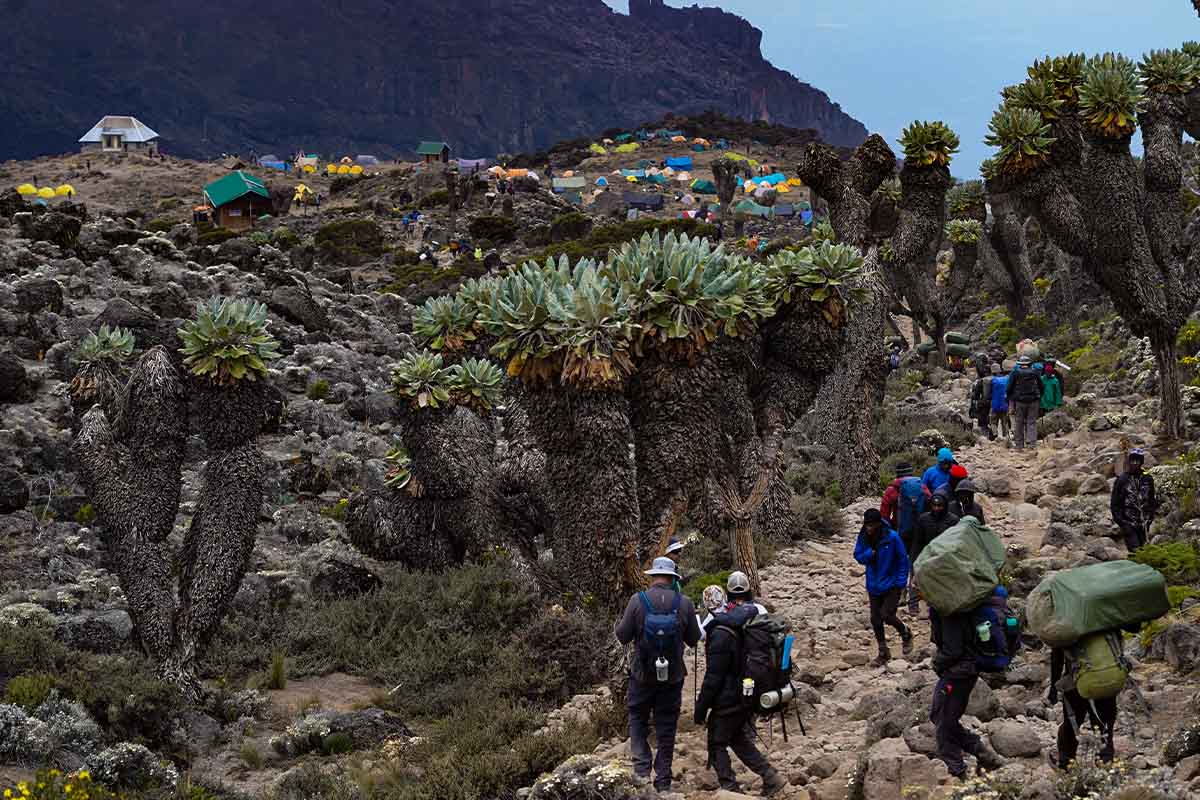
2. Higher Demand for Resources
With more climbers on the mountain, securing permits, accommodations, and guides becomes more competitive. This requires early planning and booking to ensure availability. Campsites might feel more cramped, and the increased demand on the infrastructure may impact the overall experience.
Beginners Guide to Climbing Kilimanjaro: What You Need to Know for Your Adventure
3. Light Pollution
The brightness of the full moon, while beneficial, can also reduce the visibility of stars, reducing the opportunity for stargazing—a major highlight for many climbers on clear nights. The full moon’s glow can overshadow the Milky Way and other heavenly phenomena that are typically vibrant in Kilimanjaro’s night skies.
4. Adjustment to Sleep Patterns
The brightness of the full moon can make it difficult for climbers to rest properly at campsites, especially for those sensitive to light. Adequate sleep is crucial for maintaining energy and focus during the climb, and disrupted rest may lead to fatigue, which can affect performance during the demanding summit push.
Difficulty Level of climbing Mount kilimanjaro
5. Unpredictable Weather Interactions
While a full moon generally enhances visibility, weather conditions on Kilimanjaro are unpredictable. Clouds or mist during a full moon climb can create diffused light that may reduce visibility instead of enhancing it. This could make navigation slightly harder and the overall experience less enjoyable than expected.
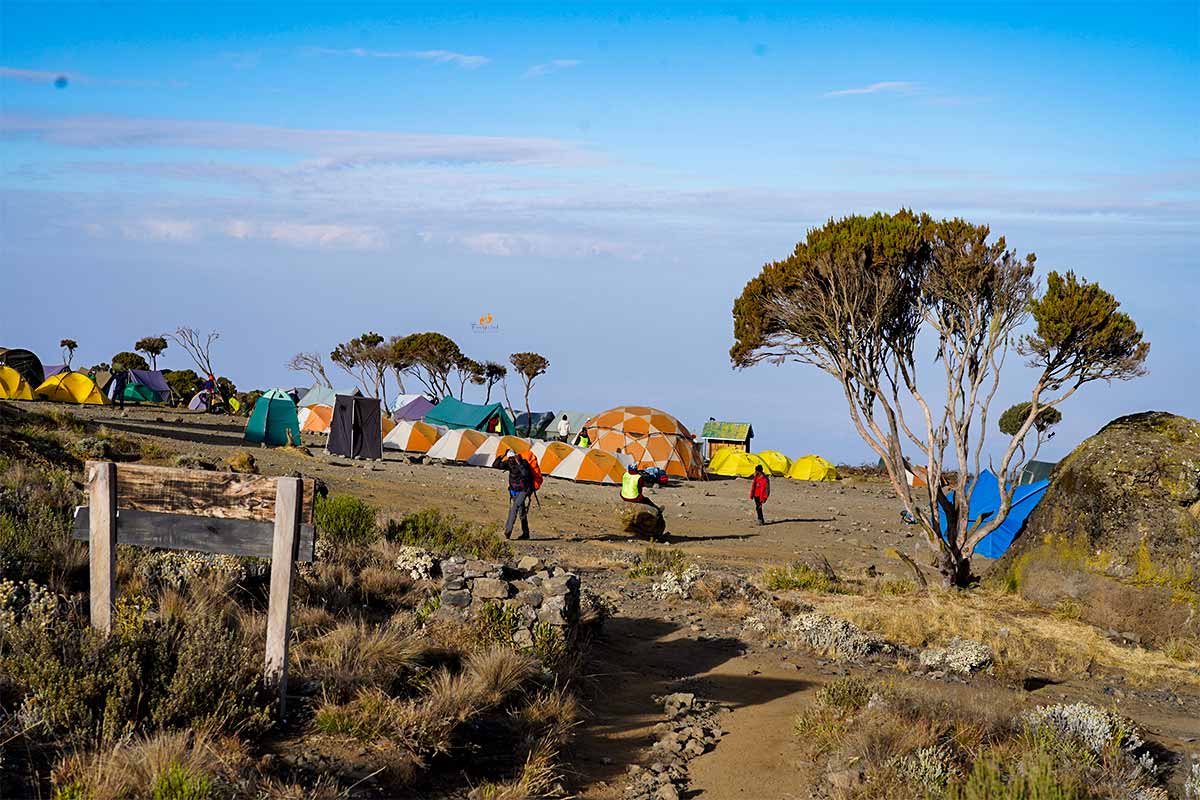
6. Pressure to Align Summit Night with the Full Moon
Climbers often plan their trek so that summit night coincides with the full moon, which can lead to a more rigid schedule. This can add pressure to maintain a specific pace or itinerary, even if conditions such as acclimatization or weather changes suggest otherwise. The focus on timing may detract from the flexibility typically encouraged during high-altitude climbs.
7. Psychological Impact of Crowds
For some climbers, the presence of large groups can feel overwhelming, particularly if they were seeking a more personal or introspective experience. The companionship of a crowded summit night might be energizing for some but could reduce from the sense of tranquility and solitude that others associate with reaching the peak.
By being aware of these challenges, climbers can better prepare for their Kilimanjaro adventure during a full moon and ensure they maximize the positives while managing potential drawbacks.
Choosing the right route for a full moon climb on Kilimanjaro is key to maximizing the experience. Each route offers unique landscapes, challenges, and perspectives, but some stand out for their suitability during a full moon trek.
The Machame Route is one of the most scenic and popular routes on Kilimanjaro. Its diverse landscapes, from lush rainforests to the alpine desert, are beautifully illuminated by the moonlight. The route’s longer acclimatization period increases the chances of a successful summit, making it a favorite among climbers.
Highlights Under the Full Moon
- Duration: 6–7 days
- Stunning views of the Shira Plateau and Barranco Wall under moonlit skies.
- A magical summit push from Barafu Camp, with the trail lit by the full moon, offering a surreal climbing experience.
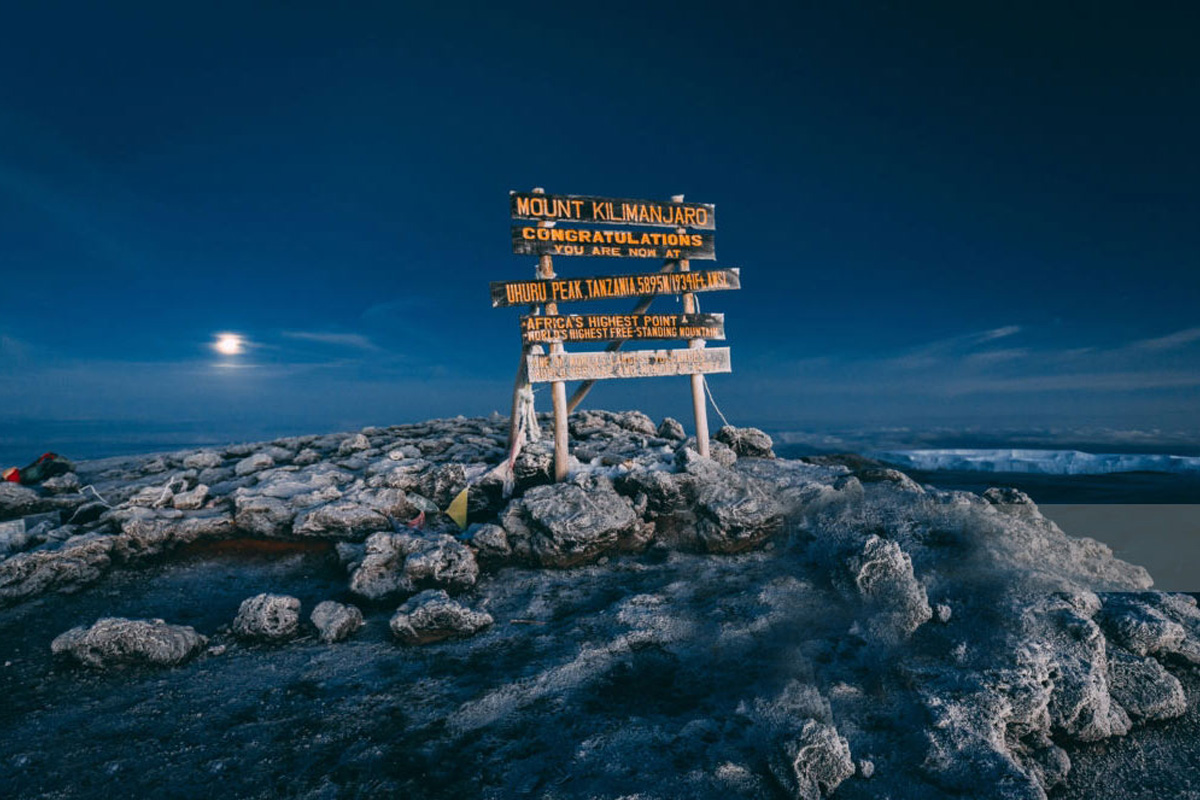
The Lemosho Route offers incredible panoramic views, making it an excellent choice for a full moon trek. This route is less crowded at the start, providing a more tranquil climbing experience before merging with the Machame Route. Its gradual ascent allows for better acclimatization, and the landscapes are breathtakingly beautiful under the moonlight.
Everything you need to know about Lemosho Route
Highlights Under the Full Moon
- Duration: 7–8 days
- Moonlit views of the Shira Plateau and Lava Tower.
- A dramatic approach to Uhuru Peak, where the full moon lights up the glaciers and surrounding plains.
The Marangu Route is the most straightforward and shortest route to the summit, making it suitable for those with limited time or less trekking experience. It is also the only route with hut accommodations, providing some comfort during the climb. The full moon enhances the route’s scenic beauty, from the lush rainforest to the summit night.
Highlights Under the Full Moon
- Duration: 5–6 days
- Moonlight reflecting off the Kibo Huts and surrounding snowfields.
- A unique perspective of the summit illuminated by the full moon.
Tips for a Successful Full Moon Climb
1. Plan and Book Early
Full moon climbs are highly sought after, so securing your spot months in advance is crucial. Choose a reputable tour operator like Footprint Adventure who specializes in Kilimanjaro expeditions to ensure a seamless experience.
2. Choose the Right Route
Selecting a route that matches your fitness level and preferences is key. While routes like Machame and Lemosho offer stunning scenery, Rongai provides a quieter, less crowded option for full moon climbers.
3. Prepare for Cold Temperatures
The clarity of a full moon night often means colder conditions. Invest in high-quality thermal gear, including insulated jackets, gloves, and sleeping bags, to stay warm throughout the trek.
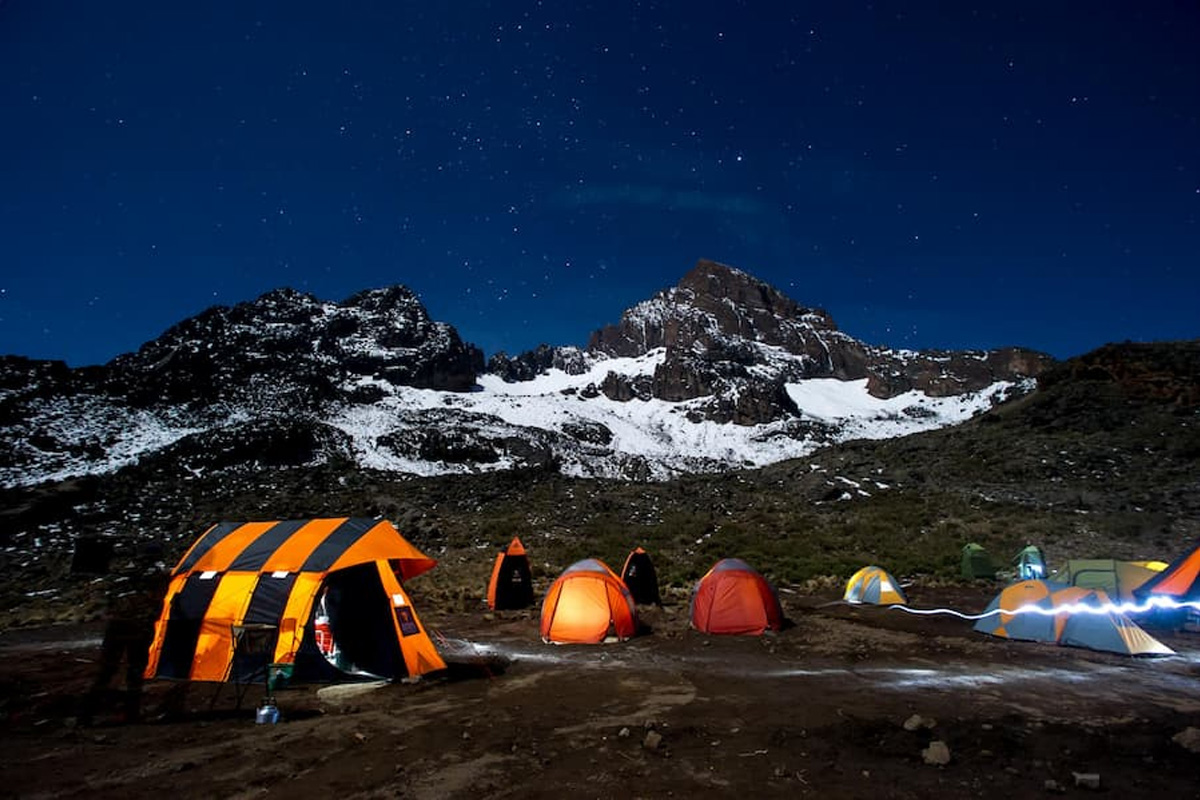
4. Pace Yourself
Altitude sickness is a common challenge on Kilimanjaro, so take your time to acclimatize. Opt for longer itineraries to increase your chances of a successful and enjoyable climb.
12-Week Training Plan for Kilimanjaro Climb: Conquering the Roof of Africa
5. Capture the Moment
Bring a good camera to capture the stunning lunar-lit landscapes. Ensure your equipment is suitable for cold temperatures and consider carrying extra batteries, as they tend to drain faster in low temperatures.
6. Stay Hydrated and Energized
Drink plenty of water and eat high-energy snacks to maintain stamina during the climb. Proper hydration and nutrition are essential for combating altitude effects and keeping your energy levels up.
7. Embrace the Experience
Beyond the physical challenge, climbing Kilimanjaro during a full moon is a spiritual and emotional journey. Take time to reflect, connect with your fellow climbers, and immerse yourself in the magic of the adventure.
Conclusion
Climbing Mount Kilimanjaro is a bucket-list adventure, and doing so during a full moon elevates the experience to an entirely new level. The enchanting beauty of moonlit trails, glowing glaciers, and panoramic night views creates a once-in-a-lifetime journey that is as magical as it is challenging. Whether you’re drawn to the physical test, the spiritual connection, or the breathtaking scenery, a full moon climb offers an unforgettable encounter with Africa’s highest peak.
By planning carefully, preparing thoroughly, and embracing the wonder of the full moon, you can make your Kilimanjaro adventure an extraordinary memory that stays with you forever. Let the allure of the moon guide your path to the summit, where dreams and reality merge under the celestial glow.
If you are interested in Climbing Kilimanjaro this 2025, contact us here.
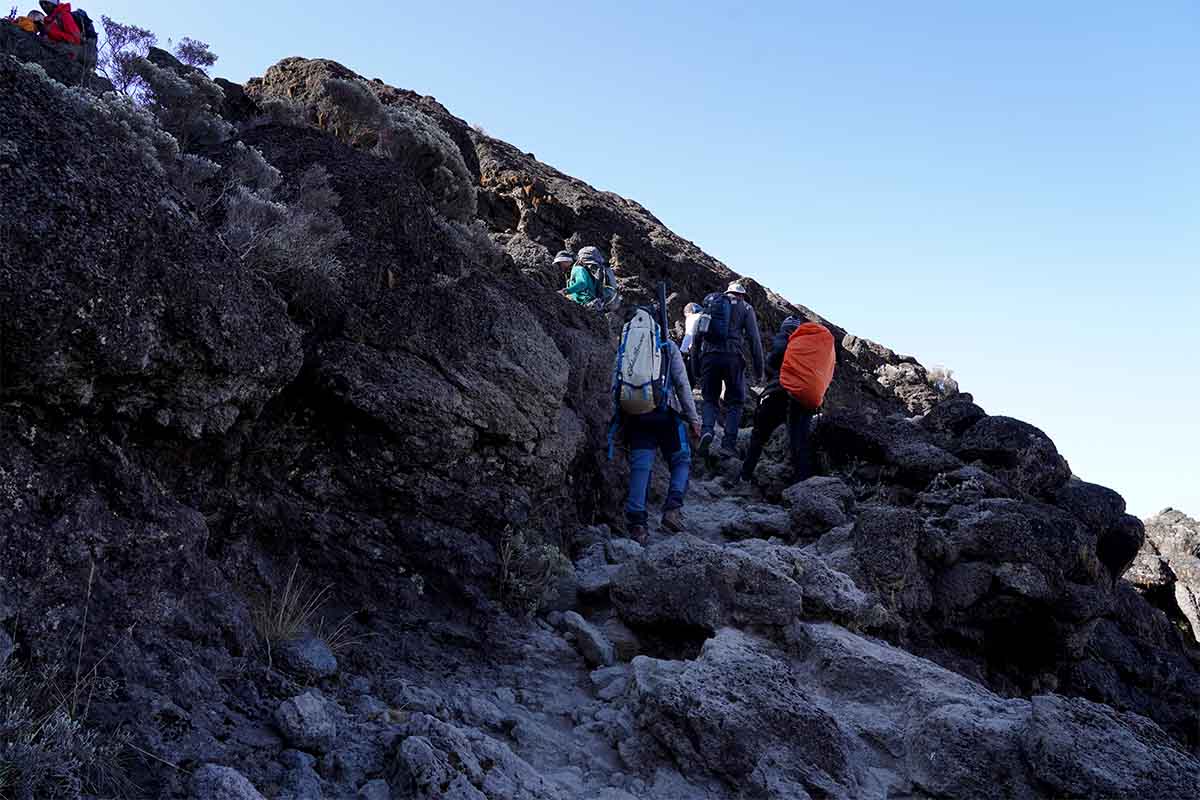




.jpg)







